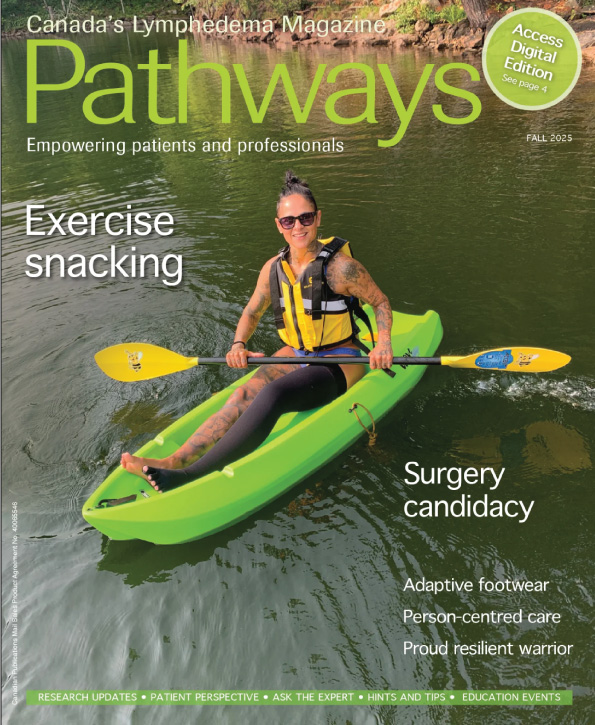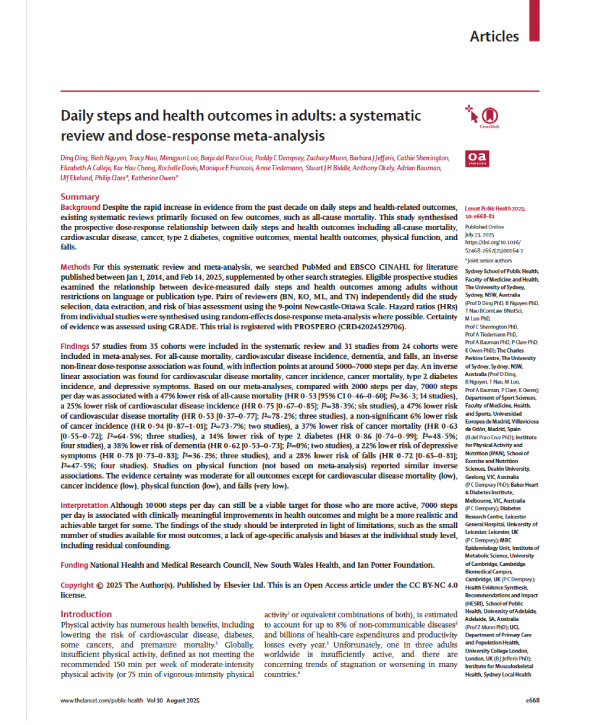Every Step Counts
Evidence-Based Strategies for Lymphoedema
Movement has always been central to lymphoedema management, but recent research continues to refine our understanding of how much and how often movement is needed to make a meaningful difference. Two recent articles, one exploring the benefits of achieving around 7,000 steps per day, and another introducing the concept of “exercise snacking”, provide fresh insights into practical, achievable ways to encourage physical activity.
Both highlight the power of small, consistent actions. Whether through steady walking or brief bursts of activity spread across the day, the message is simple: every step counts. For lymphoedema clinicians, these findings may spark new ideas for supporting clients to move more, with flexibility and confidence, within their daily lives.
You can download both full articles below:
Exercise snacking – An alternative to boost overall health.
Margie McNeely
Originally published in Pathways (Volume 14, No. 4 Fall, 2025). Copyright 2025 Canadian Lymphedema Framework. Reprinted with permission.
Daily steps and health outcomes in adults: a systematic review and dose-response meta-analysis.
Ding D, Nguyen B, Nau T, et al (2025)
The 7,000-Step Sweet Spot
The 7000 Steps paper, a systematic review and meta-analysis of 57 studies, found strong associations between daily step counts and improved health outcomes across multiple systems.
Aiming for around 7,000 steps per day was linked with:
- 47% lower risk of all-cause mortality
- 25% lower incidence of cardiovascular disease
- 38% lower risk of dementia
- 22% fewer depressive symptoms
- 28% lower risk of falls
Interestingly, while the traditional 10,000-step goal remains beneficial, the additional gains beyond 7,000 steps are relatively small for most outcomes. The research also reinforces that even 4,000 steps per day can improve health, particularly for individuals starting from low activity levels.
Clinical reflections:
- Could step tracking be a simple motivational tool for clients, helping them visualise gradual progress?
- Might small, achievable increases (for example, adding 500 steps per week) build consistency without overexertion?
- How might step goals be balanced with fatigue, pain, or swelling patterns that vary day to day?
For many clients, walking remains one of the most accessible, self-paced forms of activity. Encouraging movement within capacity, even if that means slow, short bouts, can reinforce both physical function and emotional wellbeing.
Exercise Snacking: Small Moves, Big Gains
The Exercise Snacking article reframes physical activity as short, frequent bursts of movement that can be done anywhere — no equipment required. These “snacks” may last from 20 seconds to a few minutes, offering a flexible alternative to longer, structured workouts.
Different “snacks” can target different systems:
- Cardiovascular health: marching in place, stair climbing, dancing
- Muscle strength and endurance: sit-to-stands, arm curls, squats, or leg extensions
- Lymphatic function: shoulder shrugs, diaphragmatic breathing, heel raises, and calf pumps
The article suggests starting with three sessions per day, gradually increasing to five or more, spaced across the day. For clients managing lymphoedema, this approach may integrate well with self-care routines, encouraging movement between periods of rest or during everyday activities.
Clinical reflections:
- Could exercise snacking help clients who feel overwhelmed by longer exercise sessions or limited by fatigue?
- How might we tailor short activity bursts to support both lymphatic flow and muscle activation?
- Are there creative ways to cue movement. For example, linking brief exercises with daily tasks such as waiting for the kettle to boil or brushing teeth?
Because exercise snacks are short and self-directed, they can be less intimidating and easier to sustain. Over time, these micro-sessions can build strength, mobility, and confidence, key components of lymphoedema self-management.
Translating Evidence into Everyday Support
Taken together, these papers highlight a powerful, positive shift in how we think about physical activity: movement doesn’t have to be big to be beneficial.
For clinicians, they offer a chance to:
- Encourage achievable activity goals rather than rigid prescriptions.
- Frame movement as integrated into daily life, not separate from it.
- Reinforce consistency over intensity, particularly for clients balancing multiple health needs.
- Use step counts or activity cues as gentle motivators rather than strict targets.
Even small increases in activity can enhance cardiovascular and lymphatic health, reduce sedentary time, and support mood and energy, all of which contribute to better overall outcomes for clients living with lymphoedema.
Conclusion
As lymphoedema clinicians, we know that movement underpins both physiological and psychological wellbeing. These new studies reaffirm that every step, shrug, and stretch matters — whether taken during a morning walk or squeezed in between appointments.
Encouraging clients to find their own rhythm, one that feels realistic and rewarding, can help sustain lifelong habits of movement. And perhaps, as the research reminds us, the path to better health is simply a few more steps, or a few more “snacks”, each day.






